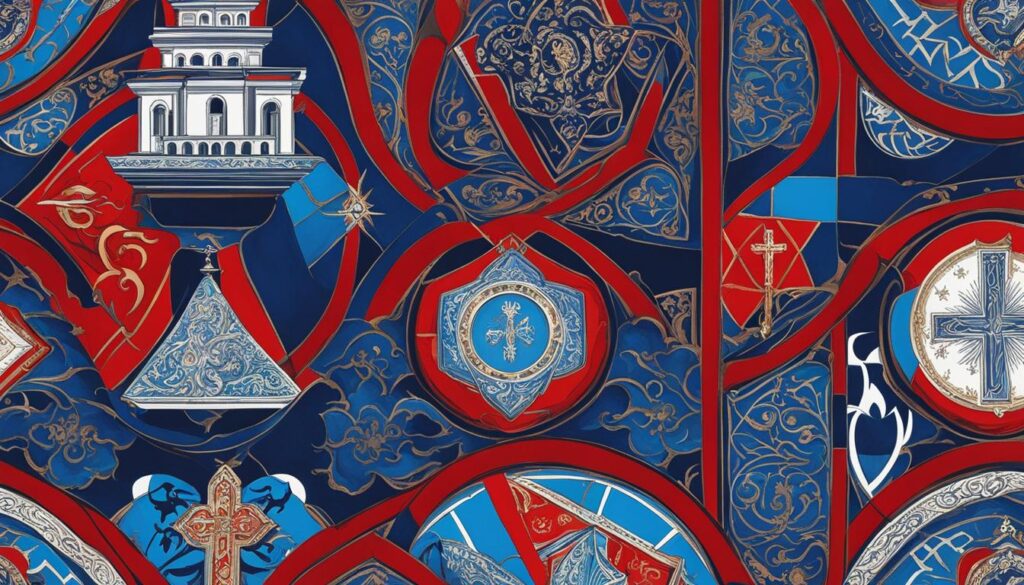The Eastern Orthodox and Catholic Bibles have some differences in their canons of Scripture. While everything in the Catholic canon is included in the Eastern Orthodox canon, the Eastern Orthodox have additional books such as 3 & 4 Maccabees, Psalm 151, The Prayer of Manasseh in Chronicles, and 1 Esdras. The Eastern Orthodox have a more fluid understanding of canon, considering it acceptable for liturgical reading, whereas the Catholic Church has precise definitions and specific accepted books.
Key Takeaways:
- The Eastern Orthodox Bible includes additional books not found in the Catholic Bible.
- Eastern Orthodox canon has a more fluid understanding, allowing for liturgical reading.
- The Catholic Church has precise definitions and specific accepted books in its canon.
Historical Background of Eastern Orthodox and Catholic Bibles
The historical background of the Eastern Orthodox and Catholic Bibles sheds light on the differences in their canons of Scripture. Before the Great Schism in the 11th century, there were minor variations in the Old Testament canon. Each city-church had its own local canon, resulting in discrepancies between the Eastern Orthodox and Catholic Bibles.
The canon of the Catholic Church was solidified in the late 4th century, with the Pope promoting a canon based on the city-churches of Rome and Alexandria. The North African bishops, including St. Augustine, played a significant role in working out the final Old and New Testament canons for the universal Church, which became the present canon of the Catholic Church. On the other hand, the Eastern Orthodox Church did not universally adopt this canon, leading to variations in their published canons today.
The historical context of the formation of the canons reveals the differing approaches of the Eastern Orthodox and Catholic churches to the establishment of the biblical canon. The Catholic Church sought to define a precise canon based on a set of accepted books, while the Eastern Orthodox Church embraced a more fluid understanding of canon, considering it acceptable for liturgical reading. This historical background provides essential insights into the unique canons of the Eastern Orthodox and Catholic Bibles.

Table: Differences in the Historical Background of Eastern Orthodox and Catholic Bibles
| Eastern Orthodox Bible | Catholic Bible |
|---|---|
| Formation of canons varied between city-churches | Canon solidified based on city-churches of Rome and Alexandria |
| More fluid understanding of canon | Precise definitions and specific accepted books |
| Regional and local approaches to canonicity | Universal approach to canonicity |
The Apocrypha in Eastern Orthodox and Catholic Bibles
The Apocrypha, also known as the Deuterocanonical books, are a group of books written by Jewish authors during the last two centuries BC and the first century AD. These books were officially excluded from the Hebrew canon due to their esoteric content. The Greek Septuagint translation of the Jewish Scripture included the Apocrypha. When the New Testament was being formed, the Early Church used the Greek Septuagint as the Old Testament of the Christian Bible. However, Jewish rabbis later revised their Scripture and excluded some portions of the Greek Septuagint, forming the canon of Judaism. The Catholic and Orthodox Churches continued to base their Old Testaments on the Greek Septuagint, resulting in more Old Testament books in their Bibles compared to most Protestant versions.
Eastern Orthodox Bible
The Eastern Orthodox Bible includes additional books in the Old Testament compared to the Catholic Bible. These books, such as 3 & 4 Maccabees, Psalm 151, The Prayer of Manasseh in Chronicles, and 1 Esdras, are part of the Apocrypha. While the Catholic canon includes everything in the Eastern Orthodox canon, the Eastern Orthodox have a more fluid understanding of canon, considering it acceptable for liturgical reading. The inclusion of the Apocrypha in the Eastern Orthodox Bible is a result of historical practices and the influence of regional Liturgical traditions.
Catholic Bible
The Catholic Bible follows the canon established by the Council of Rome in the late 4th century. This canon, which is based on the canons of the city-churches of Rome and Alexandria, defines the precise set of accepted books in the Catholic Church. The Catholic canon does not include the additional books found in the Eastern Orthodox Bible. The Catholic Church upholds specific definitions and a fixed number of books in its canon, distinguishing it from the more fluid understanding of canon in the Eastern Orthodox Church.
| Eastern Orthodox Bible | Catholic Bible |
|---|---|
| Includes additional books from the Apocrypha | Includes only books accepted by the Council of Rome |
| Accepts a more fluid understanding of canon | Has precise definitions and specific accepted books |
| Considers additional books suitable for liturgical reading | Follows a fixed set of books for liturgical use |
The Formation of the Biblical Canon
The term “canon” originally referred to books approved for reading at the Divine Liturgy or Mass. Each city-church had its own local canon, including books for their specific Liturgy. The canon of the Bible was not universally agreed upon until the late 4th century. Pope St. Damasus of Rome initiated steps to form a universal canon that would eliminate books implying heresies. The North African bishops, including St. Augustine, worked out the final canon of the Old and New Testaments, which became the present canon of the Catholic Church. However, some Eastern Orthodox churches, particularly the Antiochian tradition, continue to include pre-Carthaginian books in their local canons due to historical practices.
Throughout history, the process of canon formation involved discerning which books were considered canonical and inspired by God. This process was influenced by various factors, including the recognition of the Scriptures of the Old Testament as divinely inspired, the local Liturgical canon, and the historical practices of different regions and traditions. While the Catholic Church solidified its canon in the 4th century, the Eastern Orthodox Church adopted a more fluid notion of what books were included in their canons. This fluid approach to canon allows for variations in the Eastern Orthodox churches as to which books they consider to be part of the Bible.
Canonical and Inspired Scriptures of the Old Testament
The formation of the biblical canon involved recognizing the canonical and inspired Scriptures of the Old Testament. The Catholic Church’s canon includes the books of the Hebrew Bible, as well as the Deuterocanonical books, which are not found in the Hebrew canon. These Deuterocanonical books, such as Tobit, Judith, and Wisdom, are recognized as canonical and inspired by the Catholic Church but are not universally accepted by the Eastern Orthodox Church.
The Eastern Orthodox Church’s local Liturgical canon plays a significant role in determining which books are considered canonical. Books that are approved for reading within the Liturgy are generally considered canonical for the Eastern Orthodox Church.
| Canonical Books | Catholic Church | Eastern Orthodox Church |
|---|---|---|
| Genesis | Yes | Yes |
| Exodus | Yes | Yes |
| Leviticus | Yes | Yes |
| Numbers | Yes | Yes |
| Deuteronomy | Yes | Yes |
| Joshua | Yes | Yes |
| Judges | Yes | Yes |
| Ruth | Yes | Yes |
| 1 Samuel | Yes | Yes |
| 2 Samuel | Yes | Yes |
| 1 Kings | Yes | Yes |
| 2 Kings | Yes | Yes |
| 1 Chronicles | Yes | Yes |
| 2 Chronicles | Yes | Yes |
| Ezra | Yes | Yes |
| Nehemiah | Yes | Yes |
| Tobit | Yes | No |
| Judith | Yes | No |
| Esther | Yes | Yes |
| 1 Maccabees | Yes | Yes |
| 2 Maccabees | Yes | Yes |
| Job | Yes | Yes |
| Psalms | Yes | Yes |
| Proverbs | Yes | Yes |
| Ecclesiastes | Yes | Yes |
| Song of Solomon | Yes | Yes |
| Wisdom | Yes | No |
| Sirach | Yes | Yes |
| Isaiah | Yes | Yes |
| Jeremiah | Yes | Yes |
| Lamentations | Yes | Yes |
| Baruch | Yes | Yes |
| Ezekiel | Yes | Yes |
| Daniel | Yes | Yes |
| Hosea | Yes | Yes |
| Joel | Yes | Yes |
| Amos | Yes | Yes |
| Obadiah | Yes | Yes |
| Jonah | Yes | Yes |
| Micah | Yes | Yes |
| Nahum | Yes | Yes |
| Habakkuk | Yes | Yes |
| Zephaniah | Yes | Yes |
| Haggai | Yes | Yes |
| Zechariah | Yes | Yes |
| Malachi | Yes | Yes |
While there are differences in the canons of the Eastern Orthodox and Catholic Bibles, both traditions hold the Scriptures of the Old Testament as divinely inspired and authoritative for their faith and practice.
Differences in Liturgical Practices
The Eastern Orthodox churches, particularly the Greek Orthodox, have a more fluid understanding of what books are considered canonical for use in their liturgies. This includes a difference in the liturgical practice of reading from the Book of Revelation. In the Greek Orthodox Liturgy, the Book of Revelation is not included in the readings, whereas in the Catholic liturgy, it is included.
This difference in liturgical practices contributes to variations in the books considered canonical among different Eastern Orthodox churches. The Greek Orthodox Church has a long-standing tradition of not including the Book of Revelation in its liturgical readings. This is not the case in the Catholic Church, where the Book of Revelation is an integral part of the liturgy.
It is important to note that this difference in liturgical practices does not necessarily affect the overall canonicity of the Book of Revelation in the Eastern Orthodox Church. It is still considered part of the Eastern Orthodox canon; it is just not included in the liturgical readings. The Eastern Orthodox Church has a rich liturgical tradition that has developed over centuries, and the variations in liturgical practices are an important aspect of that tradition.
| Eastern Orthodox Liturgical Practice | Catholic Liturgical Practice |
|---|---|
| Book of Revelation not included in liturgical readings | Book of Revelation included in liturgical readings |
No Universally-Approved Biblical Canon in Eastern Orthodoxy
The Eastern Orthodox Church holds a unique perspective on the notion of a biblical canon. Unlike the Catholic Church, which has a precise and universally accepted list of books, the Eastern Orthodox Church does not possess a formal, universally-approved biblical canon. Instead, the understanding of canon in the Eastern Orthodox Church is more fluid and regional in nature.
The Eastern Orthodox Church considers books to be canonical if they are approved for reading at the Liturgy. This means that the canon can vary from one region or local church to another. While there are foundational texts that are recognized by most Eastern Orthodox churches, there is no definitive and exhaustive list of books that all Orthodox Christians agree upon.
This fluid approach to the canon has historical roots and is influenced by regional liturgical practices. Some Eastern Orthodox churches recognize books that are historically recognized but not included in the Catholic canon, such as 3 & 4 Maccabees. These books are considered canonical due to historical practices and regional liturgical customs.
The Importance of Historically Recognized Books
While there is no universally-approved biblical canon in Eastern Orthodoxy, the inclusion of historically recognized books helps to preserve the rich traditions and diverse practices within the Eastern Orthodox Church. These books provide valuable insights into the liturgical and spiritual life of Orthodox Christians throughout history and contribute to the development of regional liturgical traditions.
| Historically Recognized Books in Eastern Orthodoxy | |
|---|---|
| 3 Maccabees | |
| 4 Maccabees |
While these books may not be universally accepted as canonical by all Eastern Orthodox churches, their historical recognition and inclusion in certain local canons serve as a testament to the diverse and rich traditions within the Eastern Orthodox Church.
Influence of Regional Liturgical Traditions
The Eastern Orthodox Church’s notion of canon is strongly influenced by its regional liturgical traditions. One such tradition that has had a significant impact is the Antiochian tradition, which is part of the Byzantine Rite. The Antiochian tradition historically included certain books in their liturgy that are excluded from the Carthaginian canonical books authorized by the Councils of Trullo and Nicaea II. This historical practice has led to the inclusion of books like 3 & 4 Maccabees in the published canons of some Eastern Orthodox churches today.
The influence of regional liturgical customs highlights the dynamic nature of canon in the Eastern Orthodox Church. Unlike the Catholic Church, which has precise definitions and specific accepted books, the Eastern Orthodox Church takes a more fluid approach, considering books as canonical if they are approved for reading at the Liturgy. This allows for regional variations in the understanding of canon, as different churches may have different books approved for use in their liturgies.
While the Antiochian tradition is just one example of regional liturgical practices in the Eastern Orthodox Church, it illustrates the importance of historical customs in shaping the understanding of canon. These customs can lead to variations in the canons of different Eastern Orthodox churches, as certain books may be included or excluded based on their liturgical significance within specific regions.
| Eastern Orthodox Liturgy | Antiochian Tradition | Carthaginian Canonical Books |
|---|---|---|
| Fluid approach to canon | Inclusion of certain books | Exclusion of certain books |
| Regional variations | Historical liturgical customs | Authorized by Councils of Trullo and Nicaea II |
| Importance of liturgical practices | Shaping the understanding of canon | Precise definitions in the Catholic Church |
Conclusion
The Eastern Orthodox and Catholic Bibles share many similarities, particularly in the New Testament. However, there are notable differences in their Old Testament canons, which stem from historical and regional factors, as well as variations in Liturgical practices.
The Eastern Orthodox have additional books in their canon, such as 3 & 4 Maccabees and Psalm 151, that are not included in the Catholic canon. These additional books highlight the fluid understanding of canon in the Eastern Orthodox Church, where approval for liturgical reading is a key factor in determining canonicity.
In contrast, the Catholic Church has precise definitions and specific accepted books, resulting in a more fixed canon. The formation of the biblical canon was a gradual process, involving the efforts of Pope St. Damasus of Rome and North African bishops, ultimately leading to the present canon of the Catholic Church.
Understanding the similarities and differences between the Eastern Orthodox and Catholic Bibles is important for appreciating the diverse traditions and perspectives within Christianity. Both canons of Scripture are held in high regard by their respective churches, reflecting centuries of theological reflection and liturgical practices.
FAQ
What are the differences between the Eastern Orthodox and Catholic Bibles?
The Eastern Orthodox Bible includes additional books such as 3 & 4 Maccabees, Psalm 151, The Prayer of Manasseh in Chronicles, and 1 Esdras, which are not included in the Catholic Bible.
Why are there differences in the canons of Scripture?
The differences stem from historical and regional factors, as well as variations in liturgical practices between the Eastern Orthodox and Catholic churches.
What is the Apocrypha and how does it relate to the Eastern Orthodox and Catholic Bibles?
The Apocrypha refers to a group of books written by Jewish authors that were officially excluded from the Hebrew canon but included in the Greek Septuagint translation of the Jewish Scripture. The Eastern Orthodox and Catholic Bibles continue to use the Greek Septuagint as their Old Testament, including the Apocrypha, while many Protestant versions exclude these books.
How was the Biblical canon formed?
The canon of the Catholic Church was solidified in the late 4th century, with the Pope promoting a canon based on the city-churches of Rome and Alexandria. The final canon of the Old and New Testaments for the universal Church was established by North African bishops in the 4th century. However, the Eastern Orthodox Church did not universally adopt this canon, leading to variations in their published canons today.
Are there differences in liturgical practices related to the canons of Scripture?
Yes, the Eastern Orthodox liturgy does not include readings from the Book of Revelation, while the Catholic liturgy includes it. These differences in liturgical practices contribute to variations in the books considered canonical among different Eastern Orthodox churches.
Does the Eastern Orthodox Church have a formal, universally-approved Biblical canon?
No, the Eastern Orthodox Church considers books canonical if they are approved for reading at the Liturgy, resulting in a more fluid understanding of canon that varies among different Eastern Orthodox churches.
How are regional liturgical traditions influencing the Eastern Orthodox understanding of canon?
Regional liturgical traditions, such as the Antiochian tradition within the Byzantine Rite, historically included books in their Liturgy that are excluded from the Carthaginian canonical books recognized by the Councils of Trullo and Nicaea II. This has led to the inclusion of certain books, such as 3 & 4 Maccabees, in the published canons of some Eastern Orthodox churches today.
What are the similarities and differences between the Eastern Orthodox and Catholic Bibles?
While the Eastern Orthodox and Catholic Bibles share many similarities and include the same New Testament books, the main difference lies in their Old Testament canons. The Eastern Orthodox Bible includes additional books not found in the Catholic canon, such as 3 & 4 Maccabees and Psalm 151.



